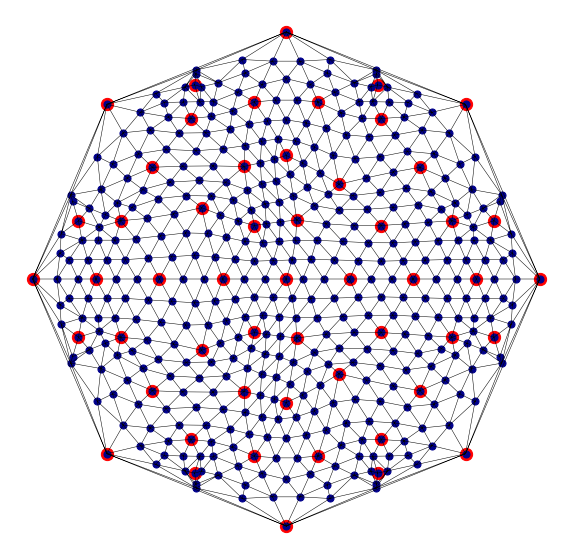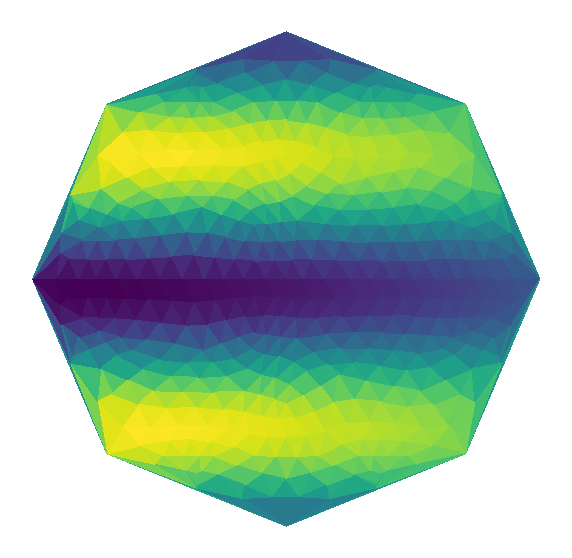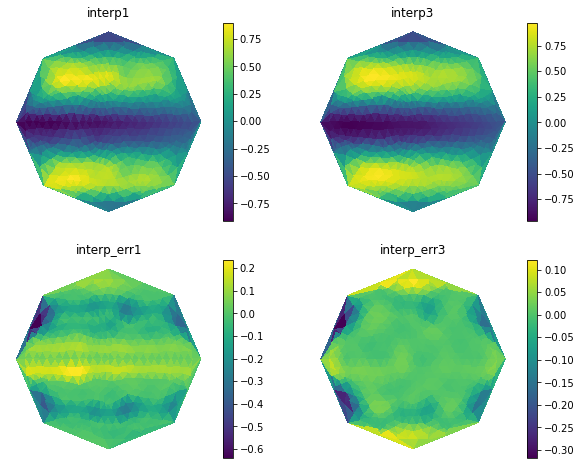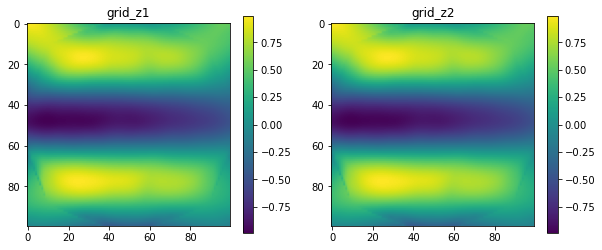Example 3 - stripy interpolation
Contents
Example 3 - stripy interpolation¶
SRFPACK is a Fortran 77 software package that constructs a smooth interpolatory or approximating surface to data values associated with arbitrarily distributed points. It employs automatically selected tension factors to preserve shape properties of the data and avoid overshoot and undershoot associated with steep gradients.
The next three examples demonstrate the interface to SRFPACK provided through stripy
Notebook contents¶
The next example is Ex4-Gradients
Define two different meshes¶
Create a fine and a coarse mesh without common points
import stripy as stripy
xmin = 0.0
xmax = 10.0
ymin = 0.0
ymax = 10.0
extent = [xmin, xmax, ymin, ymax]
spacingX = 1.0
spacingY = 1.0
cmesh = stripy.cartesian_meshes.elliptical_mesh(extent, spacingX, spacingY, refinement_levels=1)
fmesh = stripy.cartesian_meshes.elliptical_mesh(extent, spacingX, spacingY, refinement_levels=3)
print("coarse mesh points = {}".format(cmesh.npoints))
print("fine mesh points = {}".format(fmesh.npoints))
coarse mesh points = 53
fine mesh points = 437
help(cmesh.interpolate)
Help on method interpolate in module stripy.cartesian:
interpolate(xi, yi, zdata, order=1, grad=None, sigma=None) method of stripy.cartesian_meshes.elliptical_mesh instance
Base class to handle nearest neighbour, linear, and cubic interpolation.
Given a triangulation of a set of nodes and values at the nodes,
this method interpolates the value at the given xi,yi coordinates.
Args:
xi : float / array of floats, shape (l,)
x Cartesian coordinate(s)
yi : float / array of floats, shape (l,)
y Cartesian coordinate(s)
zdata : array of floats, shape (n,)
value at each point in the triangulation
must be the same size of the mesh
order : int (default=1)
order of the interpolatory function used:
- `order=0` = nearest-neighbour
- `order=1` = linear
- `order=3` = cubic
sigma : array of floats, shape (6n-12)
precomputed array of spline tension factors from
`get_spline_tension_factors(zdata, tol=1e-3, grad=None)`
(only used in cubic interpolation)
Returns:
zi : float / array of floats, shape (l,)
interpolates value(s) at (xi, yi)
err : int / array of ints, shape (l,)
whether interpolation (0), extrapolation (1) or error (other)
%matplotlib inline
import matplotlib.pyplot as plt
import numpy as np
def mesh_fig(mesh, meshR, name):
fig = plt.figure(figsize=(10, 10), facecolor="none")
ax = plt.subplot(111)
ax.axis('off')
generator = mesh
refined = meshR
x0 = generator.x
y0 = generator.y
xR = refined.x
yR = refined.y
ax.scatter(x0, y0, color="Red", marker="o", s=150.0)
ax.scatter(xR, yR, color="DarkBlue", marker="o", s=50.0)
ax.triplot(xR, yR, refined.simplices, color="black", linewidth=0.5)
fig.savefig(name, dpi=250, transparent=True)
return
mesh_fig(cmesh, fmesh, "Two grids" )

Analytic function¶
Define a relatively smooth function that we can interpolate from the coarse mesh to the fine mesh and analyse
def analytic(xs, ys, k1, k2):
return np.cos(k1*xs) * np.sin(k2*ys)
coarse_afn = analytic(cmesh.x, cmesh.y, 0.1, 1.0)
fine_afn = analytic(fmesh.x, fmesh.y, 0.1, 1.0)
The analytic function on the different samplings¶
It is helpful to be able to view a mesh to verify that it is an appropriate choice. Here, for example, we visualise the analytic function on the elliptical mesh.
def mesh_field_fig(mesh, field, name):
fig = plt.figure(figsize=(10, 10), facecolor="none")
ax = plt.subplot(111)
ax.axis('off')
ax.tripcolor(mesh.x, mesh.y, mesh.simplices, field)
fig.savefig(name, dpi=250, transparent=True)
return
mesh_field_fig(cmesh, coarse_afn, "coarse analytic")
mesh_field_fig(fmesh, fine_afn, "fine analytic")


Interpolation from coarse to fine¶
The interpolate method of the Triangulation takes arrays of x, y points and an array of data on the mesh vertices.
It returns an array of interpolated values and a status array that states whether each value represents an interpolation, extrapolation or neither (an error condition).
The interpolation can be:
nearest-neighbour (order=0)
linear (order=1)
cubic spline (order=3)
interp_c2f1, err = cmesh.interpolate(fmesh.x, fmesh.y, order=1, zdata=coarse_afn)
interp_c2f3, err = cmesh.interpolate(fmesh.x, fmesh.y, order=3, zdata=coarse_afn)
err_c2f1 = interp_c2f1-fine_afn
err_c2f3 = interp_c2f3-fine_afn
def axis_mesh_field(ax, mesh, field, label):
ax.axis('off')
x0 = mesh.x
y0 = mesh.y
im = ax.tripcolor(x0, y0, mesh.simplices, field)
ax.set_title(str(label))
fig.colorbar(im, ax=ax)
return
fig, ax = plt.subplots(2,2, figsize=(10,8))
axis_mesh_field(ax[0,0], fmesh, interp_c2f1, "interp1")
axis_mesh_field(ax[0,1], fmesh, interp_c2f3, "interp3")
axis_mesh_field(ax[1,0], fmesh, err_c2f1, "interp_err1")
axis_mesh_field(ax[1,1], fmesh, err_c2f3, "interp_err3")

Interpolate to grid¶
Interpolating to a grid is useful for exporting maps of a region. The interpolate_to_grid method interpolates mesh data to a regular grid defined by the user. Values outside the convex hull are extrapolated.
interpolate_to_gridis a convenience function that yields identical results to interpolating over a meshed grid using theinterpolatemethod.
resX = resY = 100
grid_x = np.linspace(xmin, xmax, resX)
grid_y = np.linspace(ymin, ymax, resY)
grid_z1 = fmesh.interpolate_to_grid(grid_x, grid_y, interp_c2f3)
# compare with `interpolate` method
grid_xcoords, grid_ycoords = np.meshgrid(grid_x, grid_y)
grid_z2, ierr = fmesh.interpolate(grid_xcoords.ravel(), grid_ycoords.ravel(), interp_c2f3, order=3)
grid_z2 = grid_z2.reshape(resY,resX)
fig, (ax1,ax2) = plt.subplots(1,2, figsize=(10,4))
im1 = ax1.imshow(grid_z1)
im2 = ax2.imshow(grid_z2)
ax1.set_title("grid_z1")
ax2.set_title("grid_z2")
fig.colorbar(im1, ax=ax1)
fig.colorbar(im2, ax=ax2)
plt.show()

The next example is Ex4-Gradients